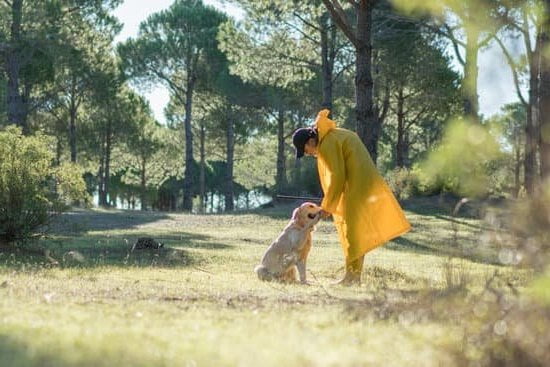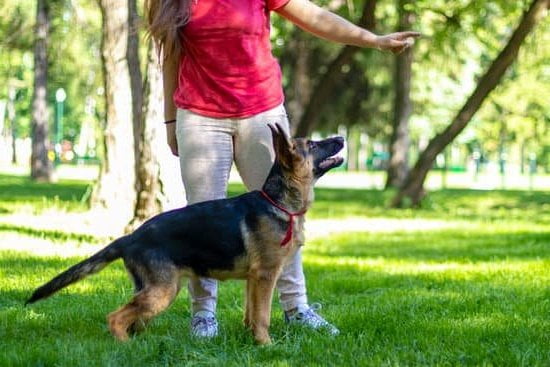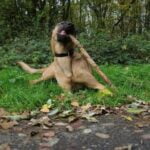Agility training is a fantastic way to engage and challenge your dog both mentally and physically. Not only does it provide a fun and stimulating activity, but it also fosters a strong bond between you and your furry companion. In this introductory section, we will explore what agility training entails and why it is beneficial for dogs of all breeds and sizes.
Agility training for dogs is an exciting sport that involves navigating through a series of obstacle courses, including jumps, tunnels, tire hoops, weave poles, and more. The goal is for the dog to complete the course accurately and quickly with the guidance of their handler. This form of training not only tests the physical abilities of the dog but also requires mental focus, discipline, and problem-solving skills.
Engaging in agility training with your dog has numerous benefits. Firstly, it provides great physical exercise which helps maintain proper weight and overall fitness. Agility training also promotes mental stimulation as dogs must quickly assess each obstacle and respond accordingly. Additionally, it aids in improving coordination, balance, speed, flexibility, and overall body awareness.
Furthermore, agility training offers an excellent opportunity to strengthen the bond between you and your furry friend. It requires clear communication between the handler and the dog through verbal cues and body language. Building this level of trust enhances obedience skills outside of agility courses as well.
Understanding the Basics
Agility training is a fun and rewarding activity for both dogs and their owners. It provides physical exercise, mental stimulation, and strengthens the bond between them. To get started with agility training, it’s essential to understand the key elements involved in this type of training.
- Obstacle Courses: Agility training typically involves navigating through a series of obstacles. These obstacles can include jumps, tunnels, weave poles, A-frames, dog walks, teeter-totters, and more. The courses are designed to mimic real-life scenarios that dogs may encounter, such as navigating through a park or agility competition.
- Equipment: To set up an agility course at home or participate in an organized class or competition, you’ll need specific equipment. Some common equipment includes jump bars at different heights for dogs to clear over, tunnels for them to crawl through, weave poles for them to navigate through in a zigzag pattern, and A-frames and dog walks for them to walk across with balance.
- Commands: Effective communication is crucial during agility training. Dogs must be familiar with basic commands such as sit, stay, come, and leave it to navigate the course successfully. It’s also essential to teach more advanced commands like “tunnel” or “weave” specific instructions for each obstacle.
To ensure a successful start in agility training, it’s vital first to plan before jumping into practice sessions. Next Section will provide guidance on preparing your dog physically and mentally before starting agility training.
Preparing for Agility Training
Before diving into agility training, it is important for dog owners to recognize the significance of preparing their dogs both physically and mentally. This preparation not only sets the foundation for successful training but also ensures the safety and well-being of the dog. When a dog is adequately prepared, they are more likely to excel in agility training and have a positive experience overall.
Physically preparing a dog for agility training involves ensuring that they are in good health and have appropriate fitness levels. Before starting any rigorous physical activity, it is crucial to consult with a veterinarian to assess the dog’s overall health, joint strength, and cardiovascular endurance. This will help determine if there are any underlying health issues or limitations that need to be taken into consideration during training.
In addition to assessing their physical health, gradually increasing the dog’s fitness levels through regular exercise can enhance their performance in agility training. Engaging in activities such as daily walks, jogging, or playing fetch can strengthen their muscles, improve endurance and flexibility, thereby preparing them for the physical demands of an agility course.
Mental preparation is equally as important as physical preparation when it comes to agility training. Dogs need to develop focus, confidence, and impulse control in order to navigate obstacles successfully. Prior to beginning agility training, incorporating mental stimulation exercises like puzzle toys, obedience training sessions, or scent games can help sharpen their cognitive abilities and enhance their problem-solving skills.
Once both physical and mental preparations have been made, dogs are better equipped to handle the challenges presented by an agility course. By investing time and effort into preparing their dogs properly, owners can lay a solid foundation for a rewarding journey towards agility mastery.
| Physical Preparation | Mental Preparation |
|---|---|
| Assess dog’s overall health with a veterinarian | Incorporate mental stimulation exercises |
| Gradually increase fitness levels through regular exercise | Sharpen cognitive abilities through puzzle toys and obedience training |
Choosing the Right Equipment
Agility training for dogs requires specific equipment that is designed to challenge their physical abilities and enhance their agility skills. Choosing the right equipment is crucial to ensure your dog’s safety and maximize their training potential. This section will provide a detailed guide on selecting the appropriate agility training equipment based on your dog’s size, breed, and skill level.
When it comes to choosing agility training equipment, one size does not fit all. Each dog has different needs and capabilities, so it’s important to consider their specific features before making any purchases. The following factors should be taken into account when selecting the right equipment:
- Size: The size of your dog plays a significant role in determining which equipment is suitable. For example, small or toy breeds may require lower jumps or narrower weave poles compared to larger breeds. Ensure that the height, width, and length of the obstacles are appropriate for your dog’s size.
- Breed: Different breeds have varying physical capabilities and tendencies. Border collies, for instance, are known for their speed and agility, whereas bulldogs may have limitations due to their body shape. Consider your dog’s breed traits when choosing equipment that allows them to perform each obstacle comfortably and safely.
- Skill Level: Dogs at different levels of agility training require different types of equipment. Beginners should start with simpler obstacles and gradually progress to more challenging ones as they gain confidence and ability. It is crucial to choose equipment that matches your dog’s current skill level to prevent frustration or injury.
| Equipment | Size Considerations | Breed Considerations | Skill Level Considerations |
|---|---|---|---|
| Jumps | Height appropriate for dog’s size | Breed tendencies (e.g., agility, jumping ability) | Lower height for beginners, gradually increasing difficulty |
| Tunnels | Length and diameter suitable for dog’s size | Body shape and breed tolerance to confined spaces | Straight tunnels for beginners, curved or longer tunnels for intermediate/advanced dogs |
| Weave Poles | Width of poles adjustable based on dog’s size and skill level | Breed tendencies (e.g., herding breeds excel in weaving) | Fewer poles and wider spacing for beginners, more poles and closer spacing for advanced dogs |
Remember that safety should always be a top priority. Ensure that all equipment is well-maintained and properly set up before each training session. It is recommended to invest in high-quality equipment specifically designed for agility training to ensure durability and safety.
By carefully selecting the right agility training equipment, tailored to your dog’s specific needs, you can provide them with an optimal training experience. This will not only enhance their physical abilities but also contribute to a successful and enjoyable agility training journey.
Essential Commands
To have a successful agility training session with your dog, it is crucial to establish a solid foundation of essential commands. These commands not only help in maintaining control and discipline but also ensure that your dog understands and responds appropriately during agility training. Here are the fundamental commands that every dog owner should teach their furry friend:
- Sit: Teaching your dog to sit on command is essential for safe and effective agility training. This command helps in controlling your dog’s movements before and after each obstacle. Start by holding a treat close to their nose, then move it upwards while saying “sit.” As their head moves up, their bottom will naturally lower into a sitting position. Reward them with the treat and praise when they successfully sit.
- Stay: The “stay” command is crucial for agility training to prevent your dog from charging ahead or wandering off during an obstacle course run. Begin by asking your dog to sit, then hold out your palm towards them and say “stay.” Take a step back and wait a few seconds before returning to reward them with treats and praise. Gradually increase the duration of stay as your dog becomes more comfortable.
- Come: A reliable recall command is vital during agility training sessions, especially when your dog needs to return to you after completing an obstacle or exercise. To teach this command, start in a distraction-free environment. Say “come” while gently tugging on the leash or using a long line, then reward them when they come to you. Repeat this exercise often, gradually introducing more distractions and increasing the distance between you and your dog.
- Leave It: The “leave it” command is essential for keeping your dog focused on the task at hand rather than being distracted by objects or other dogs during agility training. Begin by showing them a treat in one hand while making a fist. Say “leave it” firmly and wait for them to stop trying to get the treat. Once they divert their attention from your fist, reward them with a different treat and praise.
By practicing and reinforcing these essential commands consistently, you will create a strong foundation for successful agility training sessions with your dog. Remember to keep each training session short, positive, and rewarding to keep your dog engaged and excited to learn.
Mastering the Obstacles
Agility training for dogs involves navigating a variety of obstacles with speed and precision. In order to successfully compete or simply have fun in agility courses, it’s important for both dog owners and their furry companions to understand and master the different types of obstacles commonly found in these courses. In this section, we will break down each obstacle and provide training techniques specific to each one.
One of the most common obstacles in an agility course is jumps. Jumps come in different heights and designs, including bar jumps, tire jumps, panel jumps, and triple jumps. Training your dog to jump effectively requires teaching them how to approach the jump at a running pace without knocking it over or touching the bar.
Start by introducing a low jump height and gradually increase it as your dog becomes more comfortable and skilled. Use positive reinforcement techniques such as treats or toys to reward your dog every time they successfully clear the jump.
Another frequently encountered obstacle is tunnels. Tunnels require dogs to navigate through a long tube made of fabric or plastic. Start by laying out the tunnel in a straight line without any bends or twists. Encourage your dog to enter one end of the tunnel with their favorite toy or treat as motivation. Gradually introduce curves and bends into the tunnel to mimic real-life agility course scenarios.
Weave poles are another challenging obstacle that requires dogs to move quickly and skillfully through a series of upright poles arranged in a straight line with small spaces between them. Teaching your dog how to weave through these poles can be achieved using two popular methods: channel weaving and guide wires weaving.
Channel weaving involves setting up parallel lines of cones or other markers on either side of the weave poles, creating a narrow pathway for your dog to follow. Guide wire weaving incorporates physical guides, such as a string or rope, attached to the weave poles to provide a visual aid and help your dog navigate through the poles.
By mastering these key obstacles, you and your dog will be well-equipped to excel in agility courses. Remember to be patient and consistently practice each obstacle until your dog is comfortable and confident. The bond between you and your furry friend will strengthen as you work together to overcome these challenges.
| Obstacle | Training Technique |
|---|---|
| Jumps | Gradually increase height; use positive reinforcement |
| Tunnels | Start straight, then introduce curves; use toys or treats as motivation |
| Weave Poles | Channel weaving or guide wire weaving techniques for guidance |
Step-by-Step Training Methods
Agility training for dogs requires a step-by-step approach to ensure success and progressive improvement. By following a comprehensive training plan, dog owners can effectively introduce each obstacle, teach proper techniques for approach and execution, and gradually increase difficulty. Here is a breakdown of the step-by-step training methods for agility training:
- Introducing Each Obstacle: The first step in agility training is to introduce your dog to each obstacle individually. Start with the simplest obstacle, such as a low jump or tunnel, and allow your dog to explore and investigate it at their own pace. Use positive reinforcement, like treats or toys, to encourage them to interact with the obstacles in a positive manner.
- Proper Techniques for Approach and Execution: Once your dog is comfortable with each individual obstacle, it’s time to focus on proper techniques for approach and execution. Teach your dog cues or commands that you will use during agility training, such as “jump” for jumps or “tunnel” for tunnels. Practice guiding your dog through each obstacle using these commands and reward them when they complete it successfully.
- Gradually Increasing Difficulty: As your dog becomes more proficient with each obstacle and command, gradually increase the difficulty level by adding more complex obstacles or combining multiple obstacles together in a sequence. This will challenge your dog’s agility skills and improve their overall performance.
To ensure effective training, consistency is key. Practice regularly with your dog and reinforce positive behaviors consistently throughout the training process.
In addition to following these step-by-step training methods, it’s important to remember that every dog learns at their own pace. Be patient and understanding while working with your furry friend during agility training. Celebrate even small victories along the way as progress takes time.
By following this comprehensive approach outlined above, you can establish a solid foundation for agility training with your dog and set yourselves up for success as you progress through more advanced courses and challenges in the future.
Troubleshooting Common Challenges
Dealing with Fear and Hesitation
One common challenge that dog owners may face during agility training is when their dog shows fear or hesitation towards certain obstacles. This can be a result of a lack of confidence or a previous negative experience. To address this issue, it is important to take a patient and gradual approach.
Start by introducing the obstacle at a distance and using positive reinforcement, such as treats or praise, to help build your dog’s confidence. Gradually decrease the distance until your dog feels comfortable approaching and interacting with the obstacle.
If your dog continues to show fear or hesitation, it may be helpful to break down the obstacle into smaller components. For example, if your dog is afraid of tunnels, start by introducing them to just the entrance of the tunnel and reinforce positive behavior with rewards. Once they are comfortable with this step, gradually progress towards having them enter the tunnel fully.
Additionally, providing a calm and supportive environment is crucial in helping your dog overcome fear or hesitation. Avoid forcing your dog to interact with an obstacle or punishing them for being afraid. Instead, offer reassurance and support while slowly building their confidence through positive reinforcement.
Managing Distractions
Distractions can pose challenges during agility training as they can divert your dog’s attention away from the task at hand. To address this issue, it is recommended to gradually introduce distractions into training sessions once your dog has mastered the basic commands and obstacles.
Start with mild distractions such as toys or food placed nearby while performing an obstacle. Gradually increase the difficulty level by introducing more distracting elements such as noise or other animals in the vicinity. It is important to reward your dog for maintaining focus despite distractions and avoid punishing them for getting distracted.
Another effective strategy for managing distractions during agility training is teaching a “focus” command. This involves training your dog to maintain eye contact with you regardless of the distractions present. Begin by using treats or toys as a reward for maintaining eye contact, and gradually increase the difficulty level by introducing distractions while giving the command.
Addressing Lack of Motivation
Sometimes, dogs may display a lack of motivation during agility training, which can be challenging for dog owners. One key aspect to consider is keeping training sessions fun and engaging. Incorporate play and rewards into the training routine to motivate your dog. Use high-value treats or toys that your dog particularly enjoys as rewards for successful completion of obstacles.
Another effective way to address lack of motivation is by varying the training routine. Dogs can become bored if they are constantly repeating the same obstacles in the same order. Introduce new challenges or rearrange the obstacle course layout to keep your dog mentally stimulated and motivated.
It is also important to ensure that you are providing clear communication signals to your dog during agility training. Dogs can become demotivated if they are confused about what is expected of them. Additionally, maintaining a positive and enthusiastic attitude as a trainer can greatly influence your dog’s motivation levels.
By addressing fear or hesitation, managing distractions, and boosting motivation during agility training sessions, you can help your dog overcome common challenges and achieve success on the agility course. Remember that patience, consistency, and positive reinforcement are key elements in troubleshooting these obstacles and achieving a rewarding experience with your furry friend.
Safety First
Agility training is an exhilarating and challenging activity for both dogs and their owners. However, it’s essential to prioritize safety during training sessions to prevent injuries and ensure the well-being of both the dog and the owner. With proper precautions and preventive measures, agility training can be a safe and enjoyable experience for everyone involved.
Investing in Safety Equipment
When it comes to agility training, having the right safety equipment is crucial. The most important item is a well-fitting harness or collar that provides comfort and security without restricting movement. This will help prevent choking or injury if the dog pulls or jumps forcefully during an obstacle.
Additionally, using a sturdy leash is vital to maintain control over your dog’s movements while allowing them enough freedom to navigate the obstacles. Opt for a leash made from durable materials with a secure attachment point.
Another essential piece of equipment is protective gear for yourself, such as gloves and knee pads. These will provide added protection against scratches, bruises, or falls that may occur during training sessions.
Creating a Safe Training Environment
Before starting agility training, it’s important to create a safe environment for your dog. Make sure your training area is cleared of any potential hazards, such as sharp objects or toxic substances. Secure gates and fences are also necessary to prevent your dog from wandering off or getting into dangerous situations.
When setting up obstacles, ensure they are sturdy and properly secured to prevent them from toppling over or collapsing during training. Regularly inspect all equipment for any signs of wear and tear that could pose a safety risk.
During hot weather, pay close attention to your dog’s hydration levels by providing plenty of fresh water breaks throughout the session. Avoid training during extreme temperatures to prevent heatstroke or paw pad burns on hot surfaces.
Gradual Progression and Positive Reinforcement
To minimize the risk of injury during agility training, it’s crucial to gradually increase the difficulty level of the obstacles. This allows your dog to build strength, coordination, and confidence at a manageable pace. Rushing through the training process can lead to strain or sprain injuries.
Additionally, incorporating positive reinforcement techniques into your training methods will help create a safe and enjoyable experience for your dog. Rewarding them with treats, praise, or toys when they successfully complete an obstacle encourages them to associate agility training with fun and builds their motivation.
Remember to always listen to your dog’s cues and provide breaks when needed. Overexertion or fatigue can increase the risk of injury, so it’s important to understand your dog’s limits and respect them.
By prioritizing safety during agility training, you can create a secure and enjoyable environment for both you and your furry friend. Taking proper precautions and preventive measures will help minimize the risk of injuries and allow you to focus on strengthening the bond between you and your dog throughout the exciting journey of agility training.
Celebrating Progress and Enjoying the Process
Agility training is not just about reaching the finish line; it is a journey that should be celebrated every step of the way. As dog owners engage in this exciting activity with their furry friends, it is crucial to appreciate and enjoy the process. By embracing the progress made by both the dog and the handler, agility training becomes a fulfilling experience that strengthens the bond between them.
One of the most rewarding aspects of agility training is improved communication between dog and owner. Through regular training sessions, dogs become more attuned to their owner’s cues and commands, developing a deeper understanding of each other. This enhanced communication enables smooth teamwork on the agility course, resulting in greater success and achievement. Celebrating these moments of effective communication can foster trust and strengthen the unique bond between dog and owner.
Additionally, agility training provides ample opportunities for celebration as dogs overcome obstacles and show growth in their skills. Each time a dog conquers an obstacle for the first time or achieves a personal best, it is cause for celebration. Acknowledging these milestones helps boost the dog’s confidence and motivation to continue improving. Dog owners should take pride in their dog’s progress and express joy through praise, treats, or playtime to make it a positive experience for both parties.
Beyond individual achievements, participating in agility training also opens doors to a vibrant community of like-minded individuals who share a passion for this activity. Competitions and events provide opportunities to meet fellow dog enthusiasts and celebrate everyone’s accomplishments together. Engaging with this community can be inspiring and motivating, making every step of agility training even more enjoyable.
Conclusion
In conclusion, agility training is a fantastic way to bond with your furry friend while improving their physical and mental well-being. Throughout this article, we have covered various key points to help you get started on the exciting journey of agility training with your dog.
We began by exploring the basics of agility training, including obstacle courses, equipment, and commands. We then emphasized the importance of preparing your dog both physically and mentally before beginning training. Choosing the right equipment for your dog’s size, breed, and skill level is crucial to ensure a safe and effective training experience. Additionally, we discussed essential commands that are necessary for successful agility training.
Next, we delved into mastering the obstacles commonly found in agility courses. We provided detailed training techniques for each specific obstacle, such as jumps, tunnels, and weave poles. Our step-by-step training methods outlined a comprehensive plan for introducing each obstacle and gradually increasing difficulty.
Additionally, we addressed common challenges that dog owners may encounter during agility training, such as fear or hesitation, distractions, and lack of motivation. Practical solutions and tips were offered to overcome these obstacles.
We cannot stress enough the importance of safety during agility training. We discussed preventive measures to ensure the well-being of both the dog and the owner throughout the process.
Finally, we want to remind you to celebrate progress and enjoy the process of agility training. The journey itself is incredibly rewarding as it improves communication and strengthens the bond with your furry friend.
Frequently Asked Questions
How do I start teaching my dog agility?
The first step in teaching your dog agility is to establish a strong foundation of basic obedience training. Your dog should be able to understand and respond to commands such as sit, stay, come, and heel before beginning agility training. Once your dog has mastered these basics, you can start introducing them to the equipment used in agility courses, such as jumps, tunnels, weave poles, and contact obstacles.
Gradually introduce each piece of equipment and use positive reinforcement techniques, such as treats or praise, to encourage your dog’s interest and participation. Break down each obstacle into smaller steps or exercises so that your dog can understand what is expected of them. Consistency and patience are key during this process.
What age should dogs start agility training?
The ideal age for dogs to start agility training can vary depending on the breed and individual development of the dog. Generally, it is recommended to wait until a dog is at least one year old before starting formal agility training. This allows time for their bones, joints, and growth plates to fully develop and mature.
However, it’s important to note that mental and physical exercise are still crucial for younger dogs in order to keep them engaged and active. You can introduce them to simpler obstacles suitable for their age and gradually increase the complexity as they grow older.
What are the commands for agility dogs?
Agility dogs are trained using various commands that guide them through different obstacles on an agility course. Some common commands used in agility training include:

Welcome to the blog! I am a professional dog trainer and have been working with dogs for many years. In this blog, I will be discussing various topics related to dog training, including tips, tricks, and advice. I hope you find this information helpful and informative. Thanks for reading!





